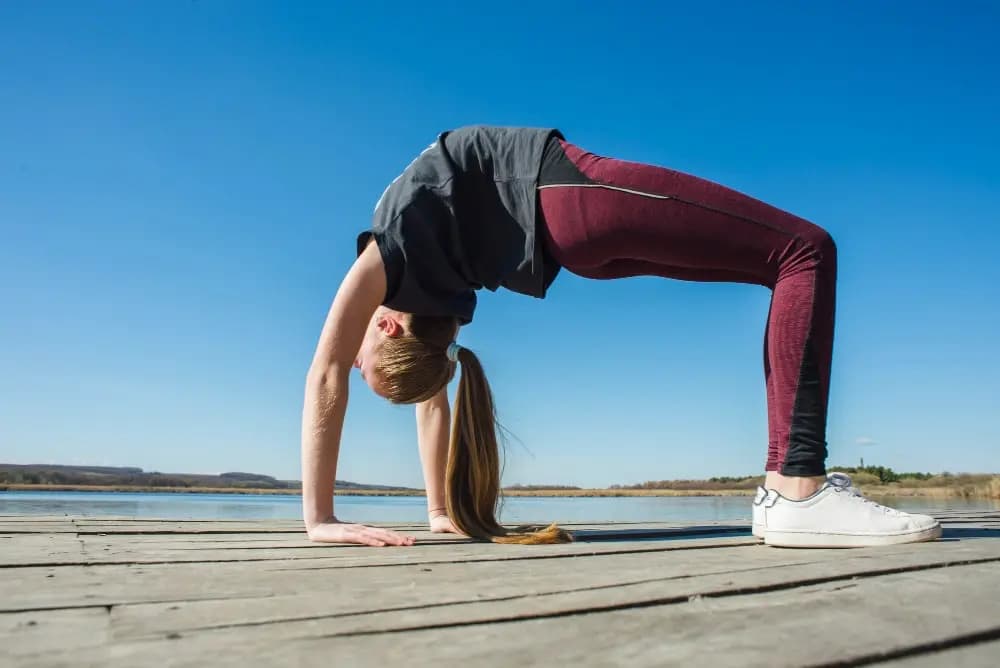Walking Crab Exercise for Strength and Mobility

MyFitnessCoach
March 3, 2025
The walking crab exercise is a powerful bodyweight movement that improves strength, coordination, flexibility, and endurance. It engages multiple muscle groups, making it a great addition to any workout routine.
This unique movement mimics the way crabs move sideways, challenging your body in ways that traditional exercises do not. Whether you're a beginner or an advanced athlete, adding the walking crab exercise to your routine can help build core strength, enhance mobility, and improve overall fitness.
In this guide, we’ll cover everything about the walking crab exercise, including how to do it correctly, its benefits, common mistakes, and variations to keep your workouts engaging.
Muscles Worked in the Walking Crab Exercise
This exercise engages multiple muscle groups, making it a fantastic compound movement for strength and mobility.
Primary Muscles Engaged:
- Shoulders (Deltoids and Rotator Cuff) – Stabilizes the movement
- Triceps and Biceps – Helps support the upper body
- Core (Abs and Obliques) – Provides balance and stability
- Glutes and Hamstrings – Helps with movement and stability
- Quadriceps and Calves – Aids in leg movement
By activating these muscles, the walking crab exercise enhances functional strength and endurance.
How to Do the Walking Crab Exercise
Performing the walking crab exercise with proper form is essential to prevent injuries and maximize results. Follow these step-by-step instructions:
Step-by-Step Guide
- Get into the starting position
- Sit on the floor with your knees bent and feet flat.
- Place your hands on the ground behind you, fingers pointing forward.
- Lift your hips off the ground so your body forms a tabletop position.
- Engage your core and keep your chest lifted
- Start moving laterally
- Move your right hand and left foot slightly to the right.
- Follow with your left hand and right foot to maintain balance.
- Continue moving sideways for 5-10 steps, then switch directions.
- Keep your hips elevated and maintain a strong posture throughout the movement.
- Repeat for 30-60 seconds or as part of a circuit workout.
Benefits of the Walking Crab Exercise
Adding the walking crab exercise to your routine offers several fitness benefits:
1. Strengthens Upper and Lower Body
Since this movement requires arm and leg coordination, it effectively targets both upper and lower body muscles at the same time.
2. Improves Core Stability
Your core muscles work hard to keep your body balanced, strengthening your abs, obliques, and lower back.
3. Enhances Coordination and Agility
The sideways movement challenges your body’s ability to coordinate movements, improving balance, agility, and mobility.
4. Boosts Cardiovascular Endurance
The constant movement elevates heart rate, making it an excellent cardio and strength-building exercise.
5. Increases Shoulder and Wrist Stability
Supporting your weight in the reverse tabletop position helps strengthen wrists, shoulders, and arms, preventing injuries.
6. Engaging Full-Body Exercise
Unlike traditional workouts, the walking crab exercise is dynamic and engaging, making it a fun way to challenge your body.
Common Mistakes to Avoid
To get the most out of this exercise, avoid these common mistakes:
- Dropping the Hips – Keep your hips elevated to maintain proper form and engage the core and glutes.
- Moving Too Fast – Perform slow, controlled movements to prevent injuries and improve muscle engagement.
- Improper Hand Placement – Ensure your hands are aligned under your shoulders and facing forward to avoid wrist strain.
- Not Engaging the Core – Keep your core tight throughout the movement for better stability and balance.
Variations and Modifications
Whether you're a beginner or looking for an advanced challenge, here are some variations of the walking crab exercise:
1. Beginner Modification: Stationary Crab Hold
- Instead of moving, hold the crab position for 30-60 seconds to build strength.
- This is great for beginners or those recovering from injuries.
2. Crab Walk with Resistance Bands
- Wrap a resistance band around your thighs or wrists to increase difficulty.
- This enhances muscle activation and strength.
3. Crab Walk to Bear Crawl
- Alternate between the crab walk and bear crawl for a full-body challenge.
- This improves agility, strength, and coordination.
4. Crab Walk with Kicks
- While moving sideways, lift one leg at a time to add an extra challenge.
- This increases core activation and leg strength.
5. Timed Speed Challenge
- Set a timer for 30-60 seconds and see how far you can crab walk without losing form.
- This builds endurance and strength.
How to Add the Walking Crab Exercise to Your Workout Routine
The walking crab exercise works well as part of:
- Warm-ups – Improves mobility before strength training.
- HIIT Workouts – Perform in 30-second intervals for a cardio boost.
- Core and Strength Training – Pair with planks, push-ups, and squats.
- Full-Body Circuits – Combine with lunges, burpees, and jumping jacks.
Example Workout Routine
- Walking Crab – 30 seconds
- Squats – 45 seconds
- Push-Ups – 30 seconds
- Bear Crawl – 30 seconds
- Plank Hold – 60 seconds
Repeat for 3 rounds for a complete workout.
Final Thoughts
The walking crab exercise is an excellent full-body movement that improves strength, coordination, and endurance. By incorporating it into your routine, you can enhance muscle stability, mobility, and overall fitness.

Looking for a structured workout plan? Download MyFitnessCoach, the all-in-one fitness app, to track your progress and get customized workout plans designed for all fitness levels.
Frequently Asked Questions
Similar Articles
Stay informed with these similar articles.

MyFitnessCoach
May 9, 2025
What Sweaty Kneecaps Means and 5 Tips to Prevent It?
Ever noticed your knees getting sweaty for no reason? You’re not alone. Sweaty kneecaps might seem odd, but they’re more common than you think.

MyFitnessCoach
March 6, 2025
Arm Swing Exercise: Effective Way to Boost Your Fitness
When it comes to fitness, we often think of intense workouts, heavy lifting, or long runs. But what if I told you that a simple exercise like arm swings could be just as effective in improving your overall fitness? Arm swing exercises are easy to do, require no equipment, and can be done anywhere. Whether you're a beginner or a fitness enthusiast, arm swings can help you improve flexibility, strength, and even cardiovascular health. In this article, we’ll explore the benefits of arm swing exercises, how to do them correctly, and how you can incorporate them into your fitness routine using the MyFitnessCoach app.

MyFitnessCoach
February 24, 2025
Best Deodorant for Athletes: Stay Fresh During Your Workouts
When you're an athlete or someone who loves to stay active, staying fresh and odor-free is a top priority. Whether you're hitting the gym, running a marathon, or sweating it out during a high-intensity workout, the right deodorant can make all the difference. But with so many options available, how do you choose the best deodorant for athletes? In this article, we’ll break down everything you need to know about finding the perfect deodorant to keep you feeling confident and fresh, no matter how intense your workout gets. Plus, we’ll show you how the MyFitnessCoach app can help you stay on top of your fitness game.
